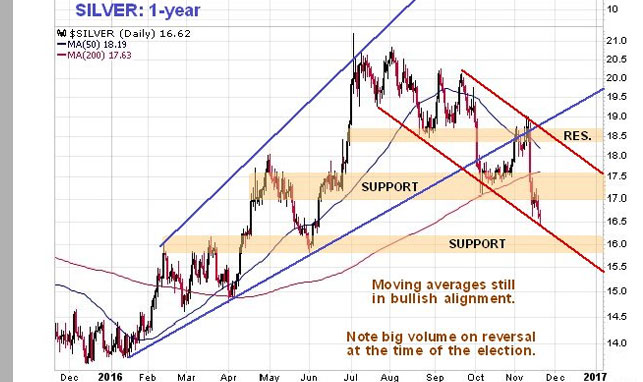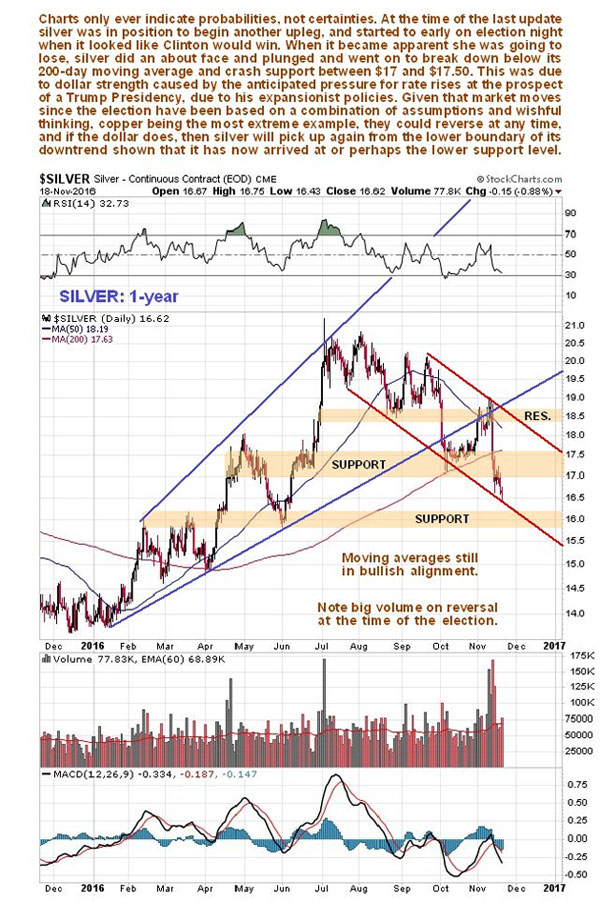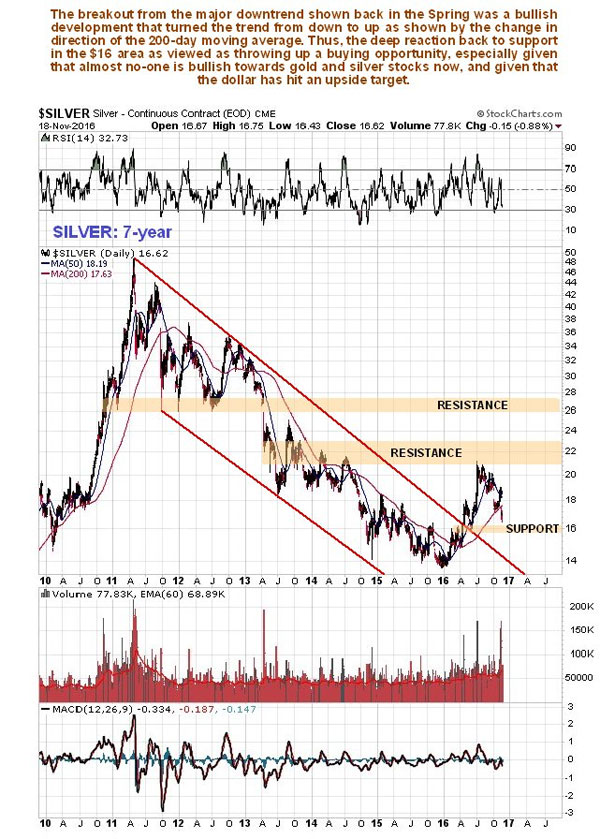9 Reasons Not to Fear Falling Silver Prices
Until recently, precious metal mining stocks had been the shining stars of Wall Street in 2016. Since the election, though, gold and silver prices have been hammered. A rising dollar, rising bond yields, a faster-growing U.S. economy, and the expectation that the Federal Reserve will raise interest rates in December have all adversely influenced gold and silver prices.
Silver, which is inherently a more volatile metal than gold since it's traded less, has been hit particularly hard. When it appeared that Donald Trump was poised for victory and the stock market futures were plunging, silver had peaked at around $19 per ounce. As of midday trading on Wednesday, Nov. 30, just three weeks post-election, silver is trading at $16.48 per ounce. That's a three-week peak-to-trough decline of more than 13%.
Now is not the time for silver investors to panic
However, panicking now would not be a smart move. There are, in fact, numerous fundamental and psychological reasons to believe that silver prices could soon find a floor and resume their bull market run.
For instance, according to the 2016 World Silver Survey from the Silver Institute, there has been a physical silver supply deficit for the past three years, including a nearly 130 million ounce deficit in 2015. Precious metals follow the same economic rules as any other good or service in that high demand and constrained supply tends to have an upward-pulling effect on prices.
Along those same lines, we've witnessed strong investor demand for silver coins and bars, steady growth for silver from the jewelry industry, and most encouraging, strong demand from the solar industry. Silver is an excellent conductor of both heat and electricity, making it a perfect conducting component for solar panels. With GTM Research and the Solar Energy Industries Association predicting that U.S. photovoltaic installation could triple between 2015 and 2020, it's not hard to see why demand for silver could continue to handily outpace supply.
Image source: Getty Images.
The opportunity cost of owning silver also remains fairly low. Even if the Fed chooses to raise rates by 25 basis points in December, bank CDs, savings accounts, and bond rates will still mostly be yielding less than, or right around, the rate of inflation. There's still not a compelling case to buy interest-bearing assets. Until there is, precious metals like silver, which have no dividend yield, should remain attractive.
Psychological factors could also wind up pushing silver's spot price higher, albeit psychological factors have less substance behind them than meat-and-potato-type data such as supply and demand. In the 20th century, the gold-to-silver ratio averaged 47-to-1. Right now, the gold-to-silver ratio is roughly 71-to-1. Some investors may see this variation from the historical norm as a reason to believe that silver could outperform gold in the somewhat near future.
Uncertainty is also expected to play a key role in fueling silver's spot price. Although the prospect of Trump's policies, which include individual and corporate tax cuts, as well as a big boost in infrastructure spending, could ignite U.S. GDP growth, Trump is a political outsider and, as such, has plenty of question marks surrounding his upcoming presidency. Precious metals have always been a default stomping ground for investors during uncertain times.
Nine reasons not to fear falling silver prices
But there's an even bigger reason why silver mining investors shouldn't be worried that silver prices have dipped 13% in a matter of three weeks - namely, the fundamental improvement in operating efficiencies and cost structures of the silver mining industry. By prudently budgeting capital expenditures and focusing on the highest ore grade mines, all nine silver stocks have established a healthy buffer between their all-in sustaining costs (AISC) - a widely followed measure of margin for mining companies - or similar cost measure and the current spot price for physical silver.
Image source: Getty Images.
Here's a look at the gross margin between each silver miner's full-year AISC forecast at the midpoint and the current spot silver price.
• Fortuna Silver Mines: $5.38 margin based on $11.10 AISC.
• First Majestic Silver: $4.55 margin based on $11.93 AISC.
• Endeavour Silver: $3.98 margin based on $12.50 AISC.
• Great Panther Silver (NYSEMKT:GPL): $3.48 margin based on $13 AISC.
• Coeur Mining (NYSE:CDE): $1.98 margin based on $14.50 AISC.
The following miners report in cash costs or AISC net of by-product costs, which don't necessarily factor in all of the costs mining companies face:
• Hecla Mining: $12.48 margin based on $4.00 cash costs, net of by-product credits.
• Silver Wheaton (NYSE:SLW): $11.97 margin based on $4.51 cash costs for silver only in Q3 2016.
• Silver Standard Resources (NASDAQ:SSRI): $7.23 margin based on $9.25 cash costs (does not include gold AISC from Seabee gold mines).
• Pan American Silver: $5.35 margin based on $11.13 AISC net of by-product credits.
As you can see, none of these silver miners is in any danger of generating losses at silver's current spot price. The closest being Coeur Mining, but even it has a good reason for its relatively high AISC compared to its peers. Coeur has been a busy bee and is transitioning from a combination of surface and underground mining operations to solely underground mining. This costly transition should work out for investors shortly since underground mining offers higher ore grades and should ultimately reduce its capital expenditures. In a year or two, investors are likely to see a rapid decline in its silver AISC. Not to mention, Coeur also repaid a $99 million term loan in July, reducing its debt by nearly 20%.
Image source: Getty Images.
Silver Wheaton has perhaps the safest margin of the group, even if it isn't a mining company in the traditional sense. Silver Wheaton works out life-of-mine or very long-term contracts with mining companies in exchange for up-front capital that they use to develop a mine or expand production. In return, Silver Wheaton accepts a percentage of production from these contracted mines at a well below-market rate. In the latest quarter, Silver Wheaton's cash costs for silver were only $4.51 per ounce. Gold and silver would have to drop considerably for there to be serious concerns about Silver Wheaton's profitability.
Personal holding Silver Standard Resources has benefited from the expected end of open pit mining at its silver mine Pirquitas. Expected costs at Pirquitas have fallen numerous times in 2016. At the same time, Silver Standard's acquisition of Claude Resources is working out marvelously. Claude's Santoy Gap is boosting Silver Standard Resources' cash flow and doing so with efficient gold cash costs.
Even the "Mighty Mouse" of the group, Great Panther Silver, is flourishing. Great Panther has already reduced its full-year AISC expectations in 2016 despite the fact that it's aggressively looking to explore and expand. Even if spot silver remains around its current level, Great Panther is expected to be cash flow positive and perhaps even profitable.
This recent swoon in silver isn't a time to panic. Instead, it could be time to go shopping.



